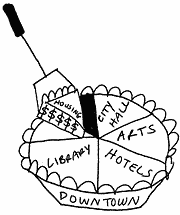An interesting battle is shaping up this summer in the Seattle City Council over a pot of money and who will receive it. At first glance the battle seems kind of wonky, but what it boils down to is this: a choice between class priorities.
The money at stake comes from downtown developers. As part of the 1985 Downtown Plan, developers pay money into a city fund designed to be used to mitigate the impact of their development. The city’s original intent was to funnel the money into affordable housing. However, officials have siphoned off more and more of the money, in small increments, for middle- and upper-class amenities such as performing arts, landmark preservation, open space, sidewalk widening, and the like. (Not that the poor don’t enjoy opera—it’s just that the rich don’t live in low-income housing.) The attrition has reached such a state that now only about a quarter of the money goes for affordable housing. This summer the City Council will be asked to change that. Expect sparks.
Two development mitigation programs are actually at stake here. The two “linkage” programs are the Transfer of Development Rights (TDR) and Bonus programs. Both affect developers who want to put up major new office buildings or hotels downtown; examples of participating projects include the Washington Mutual Tower, the Starwood W Hotel, Madison Financial Center, and the Paramount Hotel.
Both programs provide voluntary ways for builders to skirt zoning and floor area ratio (FAR) limits by giving the city money or credits in exchange for increased size or density. However, the programs are overly complicated and Office of Housing Director Cynthia Parker concedes they are used less by developers than similar, streamlined programs in other cities.
The TDR program creates what Hotel Employees and Restaurant Employees International Union researcher Dana Wise calls a “virtual market in developer rights.” The city maintains a bank of development credits that developers can contribute to or borrow against. TDRs purchased by the city through the TDR Bank Program are held for future resale to commercial developers.
The Bonus program enables developers to receive floor area bonuses—that is, greater height or density—in exchange for public amenities such as arcades, shopping plazas, and building setbacks.
Brawls, corporate welfare, and headaches
There’s much more: menus of different options developers can choose from in mixing and matching their benefits, tiers of floor area ratios that lead to various menus, a bevy of ordinances governing what sorts of projects are eligible to receive benefits under the programs, and so on. It’s headache inducing, which may in part be why the programs have received virtually no media attention.
That’s too bad, because as a result a program that is supposed to direct a sizable amount of money to cheap housing has shifted its focus almost without notice. Critics like Wise make the same charges about both programs: First, the city has tremendously undervalued its assets in light of the downtown real estate building boom. Secondly, the money the city has received is no longer going to affordable housing projects in the proportions intended by the original legislation.
According to Wise, the city has been charging about $13 a square foot—even though its own analysis says that the going rate should be closer to $80 a square foot. Meanwhile, only 27 percent of FAR credit income is being funneled into affordable housing; 73 percent goes into “other” amenities.
Last year, the Office of Housing was asked to take the lead in convening a committee of developers—eight commercial, seven nonprofit—to formulate a series of recommendations for reform. Last month the developers’ committee came up with several sweeping and radical recommendations, including a reversal of the ratio of funds so that three-quarters of proceeds would be directed to affordable housing and only a quarter to projects such as Benaroya Hall.
“This is going to turn into a serious brawl over the summer,” says Wise. City Council budget chair Jan Drago has proposed that new city facilities—like the planned library, aquarium, or city hall— receive financing through the programs. Other arts constituencies will surely line up to battle for their share of the funding. But in the midst of the worst housing crisis in Seattle’s history, it’s hard to ignore that additional development downtown carries with it an obligation to help build housing for the service workers who will work in the new hotels and office buildings. (Hence the interest of the hotel workers’ union and organized labor in general.)
The sum of money involved is not enormous; over the entire lifetime of the programs, only about $10 million has been raised. Parker notes that it’s not enough to fund an entire project by itself—but it can help substantially. And more could be raised, both by increasing the floor space charges and by making the program more attractive (e.g., simpler) for developers.
The city of Seattle has a tremendous public asset: a downtown in which developers want to build. It is, in part, a result of Norm Rice-era corporate welfare, when the city gave infamous projects like Nordstrom’s new store and Pacific Place huge subsidies in exchange for helping to create a more vibrant downtown. It’s time to cash in on that investment and return some of the benefits to taxpayers who were fleeced the first time and who are now being priced out of Seattle.
More than ever, Seattle needs affordable housing. It’s inconceivable that a program designed to provide it has been allowed to drift off into other areas of public policy, when the need is so great. Hopefully, the council will do the right thing.







